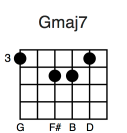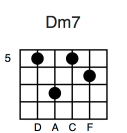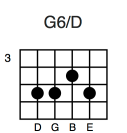This article uses Fretspace to explore chord progressions and voice leading.
One way to create interesting guitar parts is to use a succession of chords in which the notes are static (the same note is used by successive chords) or change only slightly from the previous chord. This is known as voice leading. If you use four-note chords, you can think of each note within the chord as being a separate voice (similar to four-part vocal harmony). Voice leading happens when the notes for each voice part of a chord lead naturally to notes for each voice part of the next chord.
A good way to approach voice leading is to use four-note chords that are played on the same strings in the same area of the fretboard. Here is a chord progression that uses maj7 chords on the middle four strings.




This is a simple cycle-of-fifths progression (the root note of each successive chord is a fifth below the root note of the previous chord). By using the closest available 5-4-3-2 maj7 shape in each case, we have created a natural sequence in which each part within the four-part harmony remains static or moves in a series of whole-tone steps: E D D C for the lowest part, A A G G for the next part, C# C# B B for the next part, and G# G# F# E for the highest part.
Add these shapes to a new chart in Fretspace, then select them and click on Play (or press Space) to hear what they sound like.
If we’re playing without a bass accompaniment, we might prefer to have the bass line move in fifths. One way to do this is to alternate these shapes with 6-4-3-2 shapes, as in the following example.




Select these shapes and press Play to hear what they sound like. Then create a new line with the same shapes (click on the last shape and press Return, then drag the shapes onto this new line while holding down Option). Now try inverting the first and third shapes on this new line, so that they become first-inversion chords.




This creates a sequence that has the same melody (top notes) as the progression we started with (G# F# F# E). Two of the chords no longer have root notes in the bass, but there is a strong alternative bass line which moves up by a semitone from C# to D and from B to C. When the root of a chord moves down a fifth in this way, it’s common for the third of the first chord to move up one semitone to become the root of the next chord. Another way of looking at this is to see that the cycle of fifths is actually a sequence in which each chord is a dominant chord in relation to the chord that follows, and the third degree of a dominant chord is a leading note which naturally resolves to a root note that is one semitone higher. (Dominant chords aren’t necessarily dominant seventh chords; dominant sevenths are called “dominant” because they’re commonly used in this way, but they can also be used in different ways.)
Select these shapes and press Play to hear what they sound like.
A useful thing to try at this point is to replace Amaj7/C# with an actual dominant seventh chord.




Notice how the semitone move from C# to D in the bass line is now mirrored by a semitone move from G to F# in the top part: just as the third degree of a dominant seventh tends to resolve to the root of a chord that is a fifth lower, a minor seventh degree tends to resolve to the third degree of the following chord (especially if it is a major chord). Press Play to hear what this sounds like.
Something else that you could try at this point is to take the original progression and replace some of the maj7 chords with other types of seventh chord. Add a line break (press Return) at the end of the current line if it doesn’t have one already, and option-drag the shapes on the first line so that they are duplicated at the bottom of the chart. Then use the Notes section of the Inspector panel to convert Amaj7/E to A7/E, Dmaj7 to Dm7, and Gmaj7/G to G7/D.




This creates an alternative cycle-of-fifths progression that also sounds good. For a different sound, try replacing A7/E with Am7b5/Eb: change Major Third to Minor Third and change Fifth to Diminished Fifth.
Another thing to explore is to see what happens if you take a chord and change just one or two notes at a time. I sometimes play a guitar instrumental that starts off in G major and moves to G minor in the bridge before returning to G major. The first three chords in the bridge are Gmaj7 to Cmaj7 (cycle of fifths) followed by a jump to Ebmaj7:



This is followed by:





Edim7 has two notes (Bb and G) in common with Ebmaj7 and the other two notes are just a semitone apart. This is followed by Em7, which also shares two notes (B and G) with Edim7, while the other two notes are also a semitone apart. Em7 then moves to A7/E (cycle of fifths), which also shares two notes (E and G) with Em7, while one of the other notes is just a semitone lower. A7/E is followed by Am7/E, in which only one note changes (C# moves down a semitone C) and Am7/E is followed by Am7b5/Eb where again only one note changes (E moves by a semitone to Eb). The next chord after the bridge is G/D: here Eb moves down by a semitone to D, A moves down a whole tone to G, C moves down a semitone to B, and the top note continues to be G, as it has been since since we got to Ebmaj7.

This sequence also shows how dim7 and m7b5 chords can be used as transitional chords: Edim7 is used to link to Ebmaj7 with Em7, and Am7b5 is used to link Am7 with G.
You can hear what this sequence sounds like by entering the chords within Fretspace, and pressing Play. Try holding down the Option key to hear it played as arpeggios.
You can use Fretspace to create similar progressions. This is a sequence that I made up in Fretspace.










Here, I started with a simple Dmaj7 shape, duplicated it and lowered the note on the fourth string by a semitone, by clicking at the previous fret position. I then duplicated it again and lowered the same note by another semitone. The next chord is a G chord (cycle of fifths) that shares two notes with the previous Dmaj11. This is followed by C#m7b5, which is simply the previous G6/D chord with its bottom note lowered to C#. That leads to A7/C#, which shares three notes in common with C#m7b5 and is a good chord to get to, as we’re in the key of D. Since the third degree of a dominant seventh tends to resolve up a semitone, and the seventh degree tends to resolve down by a semitone (as noted earlier) we get to the next chord by raising C# to D and lowering G to F#. This leads naturally to a simple D chord (with the top note lowered to D) followed by Dmaj7 (top note lowered by another semitone). Following the cycle of fifths, the next chord is a Gmaj7/D that shares two notes with the previous Dmaj7 chord.
One of the interesting things about this progression is that it seems pretty complex if you read the chord names, but it is actually based on a simple series of steps. You can hear what it sounds like in Fretspace. More importantly, you can use the same method to create your own progressions. Start off with a chord, duplicate it and change one or two notes, then duplicate that chord and change one or two notes again. Play back what you have at each stage. If you don’t like a chord, change it to something else. Once you have something you like, try it on a real guitar.